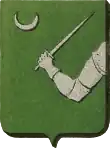Mataranga family
The Mataranga were a noble Albanian family during the 13th and 15th centuries. Members of this family included local rulers, Byzantine officials and writers. After the occupation of Albania by the Ottoman Empire, part of the family emigrated to Italy and settled in the Arbëresh villages of Piana degli Albanesi and Santa Cristina Gela in Southern Italy, where they have continued to maintain the Arbëresh language.[1]
| Mataranga Matrëngajt | |
|---|---|
| Noble family | |
 The coat of arms of the Mataranga is found in the 1875 heraldic catalog titled "Il Blasone in Sicilia", published in Palermo by Visconti & Huber. | |
| Country | Medieval Albania |
| Founded | 13th century |
| Members |
|
| Estate(s) | fiefdoms of Morgana and Mantica |
| Dissolution | 1513 |
History
Before 1284, the Matranga family was either a vassal of Charles of Anjou, in the period when he created Kingdom of Albania, or of his nephew Philip of Taranto.[2] They were first documented in 1297 in a Ragusian document. Members of the Matranga family were attacking Ragusian merchants in the region of Karavasta Lagoon.[3] Rulers of the territory between the cities of Durrës and Vlorë, they were described as subjects to the Byzantine Emperor at the time. The Matranga family might have become vassal of the Byzantine Emperor in the period between 1284 and 1288, when the region, which was part of the Kingdom of Albania, was captured by the Byzantine Empire. However they eventually threw off their allegiance with Byzantines and eagerly accepted the Angevin overlordship again in 1304, when Philip of Taranto recaptured Durrës with the help of local Albanian noblemen.[2]
During this period members of the family were also active in the Byzantine administration. A person named Mataringides, who had a part in a plot against Andronikos II Palaiologos, is mentioned as a student of Manuel Moschopoulos and led to his imprisonment for Manuel has taken a pledge for his student.[4][5] Another member of the family, Nicholas Matarangos, became one of the four general judges, member of the highest imperial court and had a prominent role in the Byzantine civil war of 1341–1347.[2]
After the oath of allegiance to Philip of Taranto, the Matrangas continued to maintain close ties with the Angevin family. The advancing Kingdom of Serbia was a source of continuous preoccupation. A certain Paul Mataranga is mentioned in 1319, together with other Albanian lords, in a coalition with Philip of Taranto against Stefan Milutin.[3] However their territories were eventually included in the Kingdom of Serbia before 1343.
After the death of Stefan Dušan (1355), a member of the family, Blasius Matarango (al. Vlash Matranga), subsequently ruled a principality in the territory between Shkumbin and Seman as sevastokrator between 1358 and 1367, recognized under the suzerainty of Simeon Uroš.[6][7] Dubrovnik was especially keen to maintain good relations with Blasius as his lands were a source of grain that was valuable to Dubrovnik merchants but this did not prevent a breakdown in 1360 during the war between Dubrovnik and Serbia. Mihaljčić, the Serbian historian, can see no other explanation for this other than the continued vassalage of Blasius to Serbia.[8]
Members
- (possibly) Matarangides (fl. 1305[9]), possibly from Dyrrhachion,[10] a student of Manuel Moschopoulos who took part in the plot against Andronikos II Palaiologos which led to his imprisonment.
- Nicholas Matarango (fl. 1341–47), one of four general judges, member of the highest imperial court, who had a prominent role in the Byzantine civil war of 1341–1347.
- Paul Matarango (fl. 1319).
- Euphemia Matarango, (albanian : Efimia/Efthimia), married to Andrea II Muzaka with whom she had 5 children.
- Blasius II Matarango.[6]
References
- Eqrem Çabej (1977). Studime gjuhësore: Gjon Buzuku dhe gjuha e tij. Rilindja. p. 109.
- Angelov 2007, p. 319
- Alain Ducellier (1981). La façade maritime de l'Albanie au Moyen âge: Durazzo et Valona du XIe au XVe siècle. Ed. de l&Ècole des Hautes Études en Sciences Sociales. p. 347.
- Angelov 2007, pp. 314-316
- Ihor Ševčenko (1981). Society and Intellectual Life in Late Byzantium. Variorum Reprints. pp. 275–276. ISBN 978-0-86078-083-0.
- Fine 1994, p. 357
- Studia Albanica. Académie des sciences de la République Populaire d'Albanie, Institut d'histoire, Institut de linguistique et littérature. 1990. p. 182.
Dans les années 1350-1367, donc après le retrait définitif de l'Empire de Byzance de l'Albanie, dans les régions de Durres et du cours inférieur de Seman (Dievali) dominait le "sebastocratore" Vlash Matranga...
- Mihaljčić 1975, p. 66
- Studia Albanica. Académie des sciences de la République Populaire d'Albanie, Institut d'histoire, Institut de linguistique et littérature. 1990. p. 178.
- C. N. Constantinides (1982). Higher Education in Byzantium in the Thirteenth and Early Fourteenth Centuries: (1204 - Ca. 1310). Cyprus Research Centre. p. 108.
Sources
- Dimiter Angelov (8 February 2007). Imperial Ideology and Political Thought in Byzantium, 1204-1330. Cambridge University Press. ISBN 978-0-521-85703-1.
- John V. A. Fine; John Van Antwerp Fine (1994). The Late Medieval Balkans: A Critical Survey from the Late Twelfth Century to the Ottoman Conquest. University of Michigan Press. ISBN 0-472-08260-4.
- Mihaljčić, Rade (1975). Крај Српског царства [End of the Serbian Empire]. Belgrade: Srpska književna zadruga.